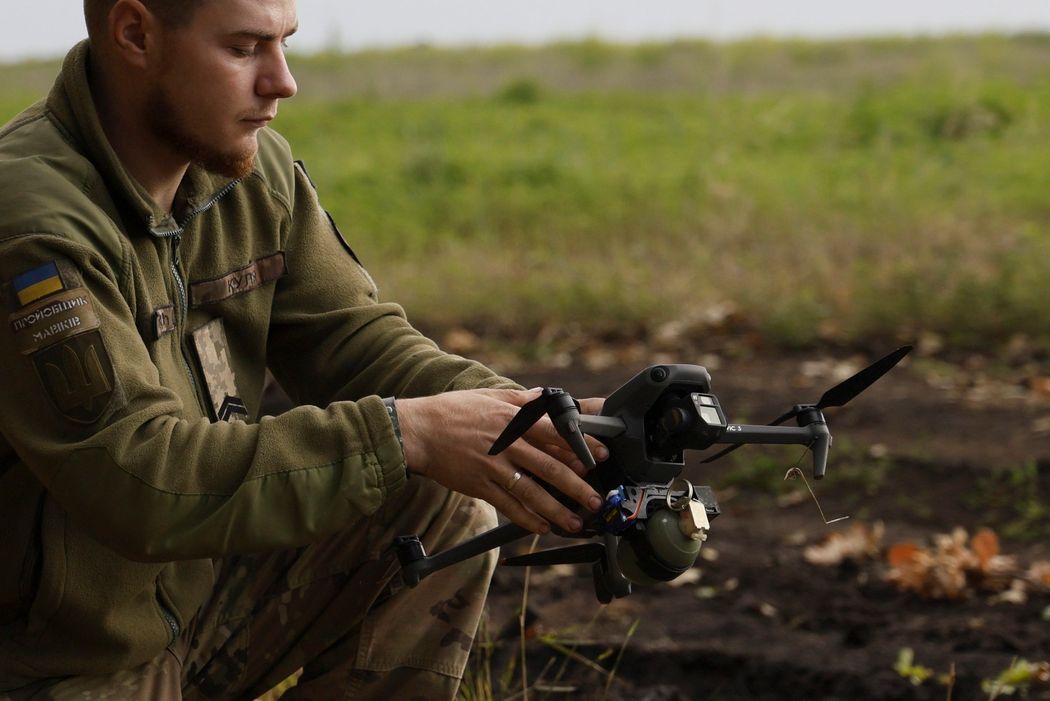By Eric Schmidt
I recently returned from an insightful journey to Ukraine, where I was confronted with a stark reality that is likely to transform the future of warfare: the increasing dominance of drones in military operations.

Caught in a struggle for sovereignty, Ukraine has faced a formidable Russian force on a front line spanning 600 miles. The Ukrainians aim to interrupt the Russian overland supply line to Crimea and gain access to the Azov Sea. The battlefields are characterised by heavily mined territories extending three miles, interspersed with concrete antitank obstacles and concealed artillery installations within the adjacent forests.
The vast resources of the Russian military allow for the expenditure of a staggering 50,000 artillery rounds per day—far surpassing Ukraine’s firepower. Traditional military wisdom dictates that the advancing force needs air superiority and a 3-to-1 soldier advantage for making steady gains against a fortified enemy. Ukraine has neither. Yet, against all odds, it has found success on the battlefield, thanks to its rapid adoption and adaptation of emerging technologies such as drones.
Drone technology has magnified the Ukrainians’ tactical capabilities. Reconnaissance drones provide an invaluable service to infantry by closely monitoring enemy advances and improving the accuracy of artillery targeting. In daylight, they soar above enemy lines to pinpoint targets, returning under cover of darkness to deliver payloads.
The Russians, however, have also embraced these tactics. Beyond the first line of defense, the Russians have fortified their positions, employing drone and artillery strikes to deter further Ukrainian advances. Meanwhile, the Russian army, proficient in jamming and GPS spoofing, is consistently aiming to neutralize Ukrainian drones. Before the counteroffensive began, Ukraine was already losing up to 10,000 drones per month, according to a May report from the Royal United Services Institute for Defence and Security Studies.
Despite these losses, Ukraine has persistently outmaneuvered the enemy by innovating drone technology. The latest Ukrainian drones can resist jamming, function without GPS, and accurately bomb moving targets. On the homefront, Ukrainian command centers use personal computers and open-source software to classify targets and orchestrate operations.
Ukraine has also successfully deployed a model of decentralized military operations that fosters rapid technological adaptation and diverse applications. Early in the war, Ukraine’s government put the new Digital Ministry in charge of drone procurement but left critical decision-making to smaller units. As a result, brigades on the ground are empowered to select and operate the drones themselves, leading to dramatic tactical shifts based on the ingenuity of small groups of innovators.
The innovations taking place on the Ukrainian battlefields have the potential to upend traditional military strategies that have dominated for over a century. Among these, the kamikaze drone stands out. These first-person-view drones, originally developed for drone racing, can be produced for less than the cost of a mortar round but offer greater accuracy than artillery fire. In skilled hands, they are nearly impossible to shoot down and can carry up to three pounds of explosives.
The future of warfare will not just be about replacing expensive materiel, like combat aircraft, with cheaper and more efficient drones. It will be about land, sea, and air drone operations, ruthless swarms of AI-powered kamikaze drones tracking mobile targets, and using algorithmic collaboration to circumvent enemy electronic countermeasures. Naval drones will carry these principles into maritime warfare, while land-based drones will clear obstacles, demine fields, and even serve as remote weaponry.
Yet, as we look towards this new age of warfare, we must remember the human cost. The drone warfare emerging in Ukraine is a chilling reminder of how these technologies can be deployed not just to protect soldiers, but also to target civilians. It shows us the best and worst of humanity, from the ruthless aggression of an invading force to the brave resistance of defenders.
As I left Ukraine, the image of rolling fields along the Dnipro River stayed with me—a testament to human resilience and the ability to overcome unimaginable adversity. From the 1930s Holodomor that killed millions through forced starvation to today’s drones-enhanced warfare, Ukraine has endured.
The world must learn from Ukraine’s experience. We must innovate and prepare for this emerging form of warfare to deter and prevent such conflicts from recurring. Our future, and the future of war, has arrived.
Eric Schmidt
Former CEO of Google, Executive Chairman of Google and its successor, Alphabet Inc., Chairman of the Special Competitive Studies Project, and Co-author of “The Age of AI: And Our Human Future.”
Author:Com21.com,This article is an original creation by Com21.com. If you wish to repost or share, please include an attribution to the source and provide a link to the original article.Post Link:https://www.com21.com/the-drone-revolution-a-glimpse-into-the-future-of-war-in-ukraine.html
